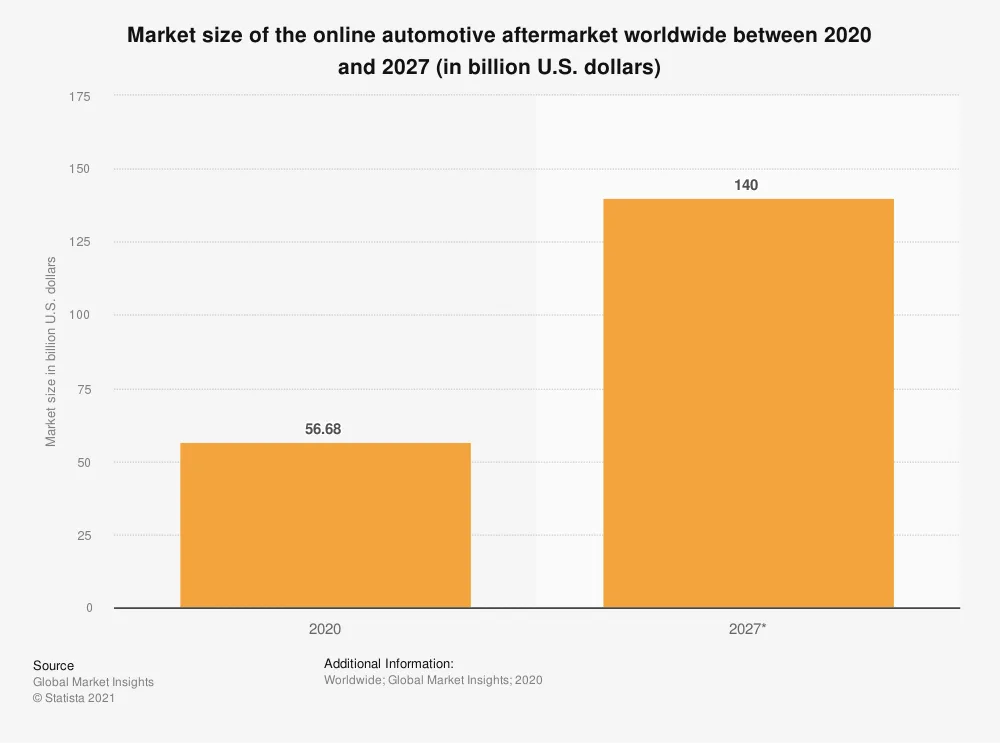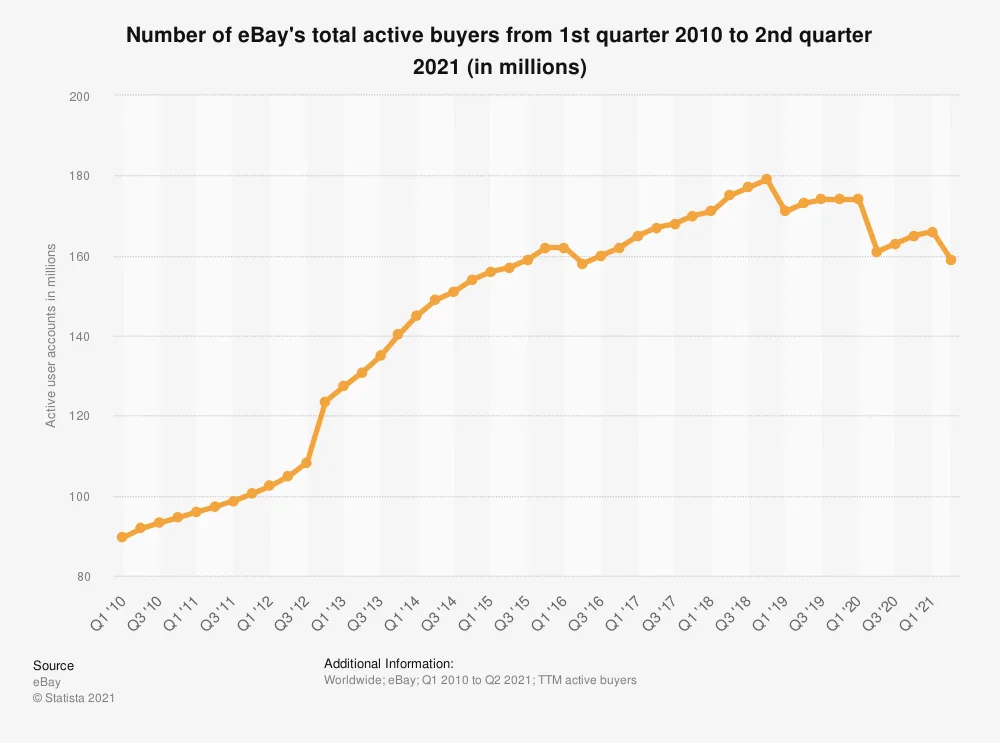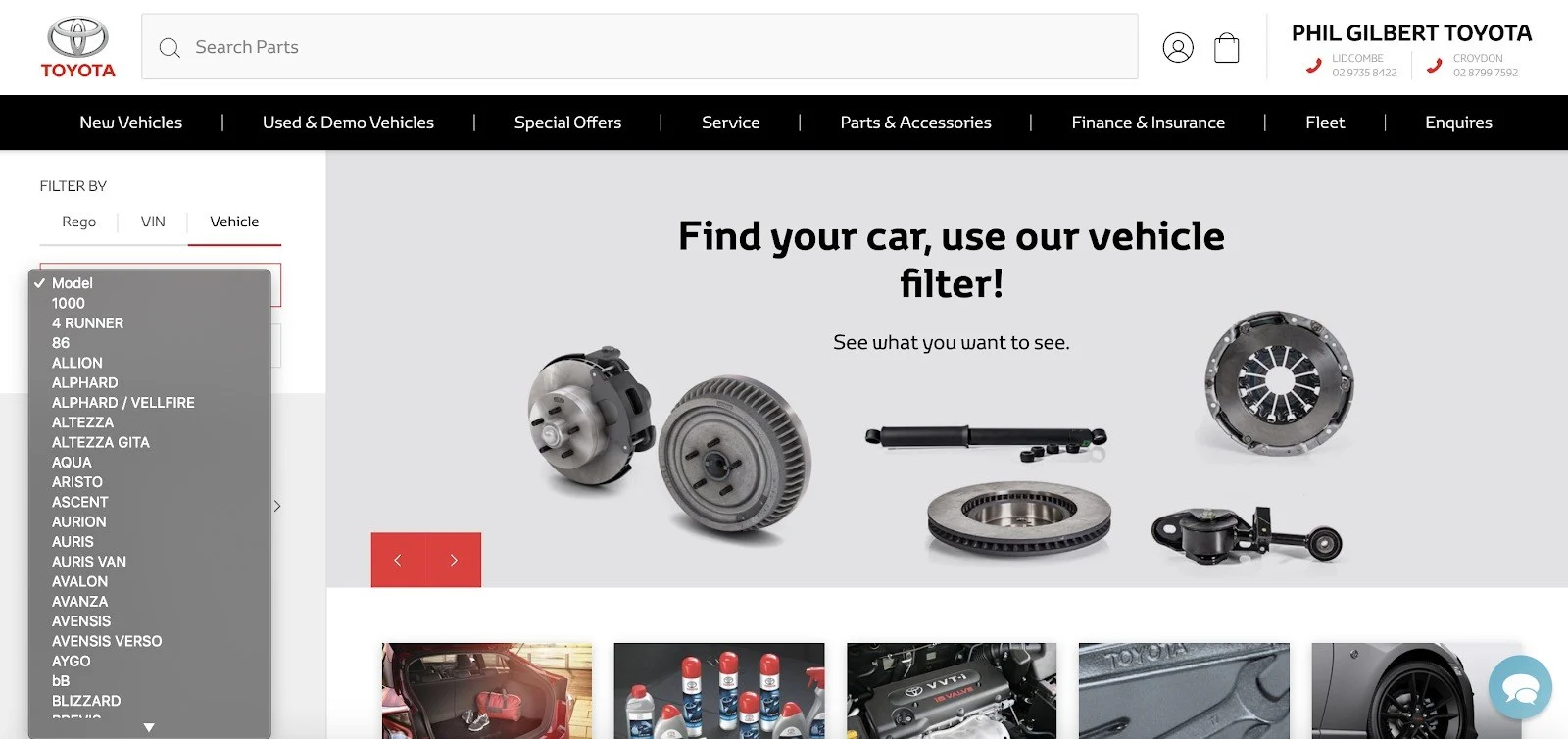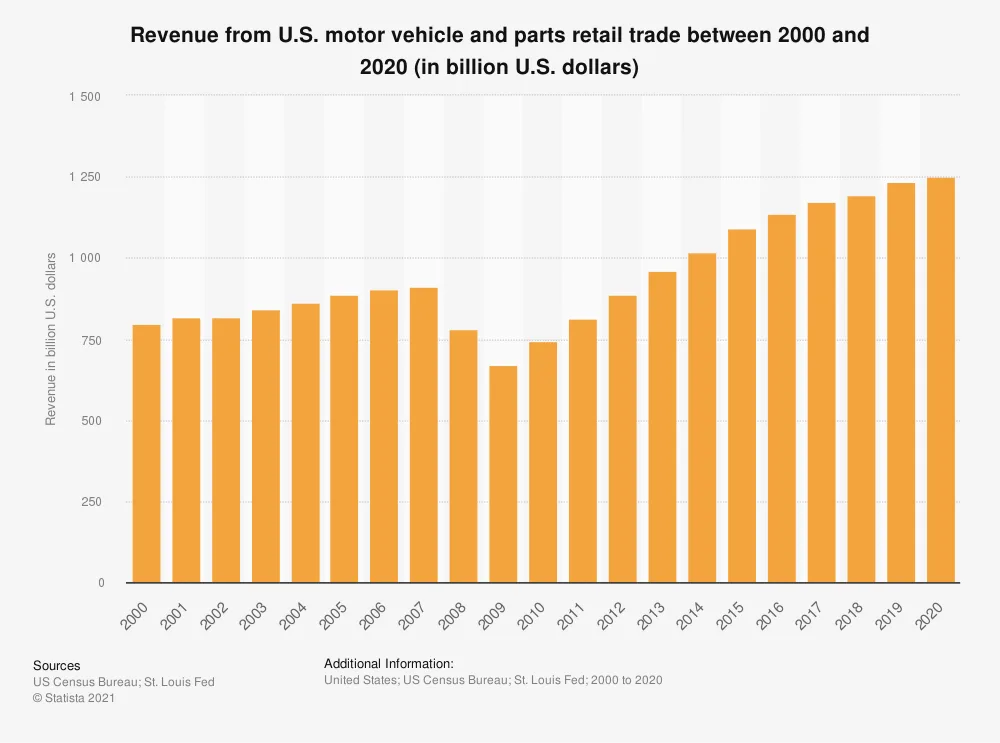The online automotive parts and accessories sales industry has skyrocketed over the past five years as brick-and-mortar retailers enter the online space.
According to Statista, this trend will only grow, as the online automotive aftermarket market size is set to nearly triple worldwide by 2027.

This shift coincides with a strong consumer uptick in online shopping. While the growth may not be as high as women’s or men’s fashion, the already $56 billion industry could prove a justifiable investment for an already-trading automotive parts store.
However, according to a McKinsey market survey, while this growth is predicted to continue at a rate of 3% per year into 2030, “80% of players [in the industry] say they are currently not well prepared – mainly due to a lack of strategic focus and skills and insufficient digitization resources.”
The question is no longer how big the automotive parts and accessories sales industry will become. Instead, now it’s all about who’s ready to expand their business and sell auto parts online?
To stay ahead of the game and prepare your business for online sales, read through this comprehensive guide to becoming an online auto parts seller.
Know What You’re Selling
It may seem simple, but there is a complex equation behind what we sell and why we sell it. Do you want to compete in the larger automotive arena or specialize in specific products?
Knowing the products you wish to sell will better help you structure your ecommerce website and provide your users with a seamless and well-structured website with a strong user experience (UX) — leading to conversions rather than bounces.
Below are some examples of the online automotive parts that customers are looking to buy online.
Externals: Bumpers, Grills, Side Mirrors, etc.
Externals are typically the best-selling auto parts found on platforms like eBay and Amazon since they are often more manageable for the layman to replace. These parts can be either OEM replacements or aftermarket upgrades because fitment is generally straightforward to determine.
External parts like these often require big shipping boxes and are less fragile than internal ones.
If you are looking to sell these products, you must consider the shipping requirements.
Which shipping company offers services that meet your product specifications?
Will you allow users to pick up the products?
Will you ship interstate?
What are the costs of interstate shipping?
Wheels and Suspension: Tires, Hubcaps, Shocks and Struts, etc.
Wheels and suspensions are often listed under externals because they perform similarly in sales.
However, installing them is a more complicated process than the typical external and requires visiting a shop or mechanic. The sales of these parts typically go away from the customer to other businesses, making this a B2B sale — with the requisite shipping plan needed.
Internals: Spark Plugs, Transmissions, Cylinders, etc.
Internal sales, while not quite as large as external sales, are still significant. Like wheels and suspensions, internals almost always have to be installed by a mechanic instead of the direct customer.
These are often more fragile and may need to be carefully packaged with lots of bubble wrap before shipping.
Similar questions also surround the choice of the shipping company and the shipping service you wish to provide your buyers. You may also need to gather an inventory of wrapping and shipping materials.
Tools: Jacks, Wrenches, etc.
These can be light tools, like a wrench, or heavy tools, like a jack. They can be sold both to customers and to auto parts businesses.
As above, it is important to consider how these items can be shipped safely and securely.
Other categories with opportunity.
Do you specialize in other automotive parts? Perhaps there is an unsaturated area of the market to specialize in. Research could prove beneficial for your product range to stand out from the rest.
Who’s Buying Your Parts?
There are many different demographics and user groups who buy auto parts online. The obvious categories include wholesale buyers — e.g., a local garage — and retail consumers — e.g., people looking to make a one-off purchase. Knowing your target market is also a consideration when designing and building your ecommerce website.
If you have a current website and want to add an ecommerce component, you can use tools like Google Analytics to analyze your current user demographic. Google Analytics allows you to track your audience by age group, gender, country, interests and more.
If you do not have a website, there is market research available online regarding the user behavior of the automotive aftermarket shopper.
Knowing your audience will help you better understand how to sell auto parts online. Below are some examples of audiences:
Auto shops, local garages, and other vendors.
You’re a B2B wholesaler, selling parts to small vendors who sell them to customers. The advantages of B2B selling can be sales stability, lower costs, and better volumes — which could result in higher sales for your business.
End consumers.
You’re selling to the kid that wants to put a loud exhaust on his 2002 Honda Civic. This demographic is B2C. One benefit of selling B2C is the ability to potentially offer shorter delivery times for smaller quantities.
The 4 Best Channels for Selling Auto Parts
It’s an omnichannel world out there. Consumers are no longer going to one place to purchase products. There is price comparison, convenience shopping and even location-driven shopping.
For the automarket industry, an omnichannel approach should prove beneficial for online sales. When you are researching how to sell auto parts online, consider the following channels:
1. Your own ecommerce store.
You have complete control over your ecommerce store. That means you won’t get hit with fees tacked on to each sale — unlike with eBay and Amazon — and you can price your products however you’d like.
A proprietary ecommerce storefront also means that you can better communicate your brand and build more direct relationships with potential customers. Customer relationships can lead to loyalty and repeat business, and customer retention can be much more cost-effective than acquisition.
Ensuring effective on-site search is a necessity for customer experience and will add a layer of complexity, but the benefits to your brand may well be worth it. With BigCommerce, building a beautiful, effective online store has never been easier. You can completely customize your auto parts website without any coding required, drive sales with responsive templates and deliver a personalized shopping experience.
2. eBay.
eBay is a great place to sell auto parts, especially if you’re selling rare parts. As of the beginning of 2022, there are nearly 160 million eBay users worldwide — double what it was in 2010.

It’s also a popular place for auto parts: according to eBay Motors, there are about 110 million active auto parts listings, and three parts or accessories are sold each second. eBay provides a number of tools to facilitate automotive sellers, including tools to help simplify adding fitment to your listings. Unlike other online platforms, eBay doesn’t charge active subscriptions. There are selling and final value fees, but with 250 free listings a month, it shouldn’t be a hassle for any burgeoning business.
3. Amazon Marketplace.
Amazon’s marketplace also helps small businesses open themselves up to a larger audience. With a user share of 82% in the United States, Amazon was by far the most used online store over the prior 12 months.
There are some things to note about using Amazon to sell your auto parts. Unlike building your own store or using Amazon, there can be significant costs. To sell auto parts, you must be on the Professional selling plan which costs $39.99 per month, along with referral fees. Automotive and Powersports is also a restricted category when selling on Amazon, with specific rules in place to protect both vendors and customers.
4. All three channels combined.
Thankfully, with an ecommerce site builder like BigCommerce, business owners don’t have to choose between eBay, Amazon and their own platform when looking at how to sell auto parts online.
Customers now shop in more places than they ever have before. With multichannel ecommerce, you can sell your products across all touchpoints — without additional development work. Connect your store with our simple, multichannel integration eBay and Amazon plugins available on the BigCommerce app store.
Finding an Ecommerce Platform to Sell Auto Parts Online
User experience is rapidly evolving and actively influences a customer's decisions when on your website. Factors such as visual merchandising, chatbot implementation, payment gateways and shipping options can impact whether your customer decides to purchase auto parts on your website. The ecommerce platform you choose will need this functionality available and, preferably, simplify the process of integration and developing this functionality for you:
Filter by vehicle.
Consumers tend to search for parts for a particular car. Create a UX that allows users to identify their vehicle, then filter to display only relevant products.
You can also allow the user to identify their vehicle with VIN or Registration look-up or manually select their vehicle.
Check out this example from Phil Gilbert Toyota:

Faceted search.
Shoppers want to find things at the touch of a button without hassle or delay. Making their life easier is the first step to delivering an excellent product delivery experience.
Faceted search can increase conversion rates and customer satisfaction by adding product filters to highlight your valuable information in an easy-to-shop format.
Loyalty programs.
Make a good impression on a mechanic, and you can bet they’ll be back again to buy more auto parts online. Get them in a loyalty program and give them discounts and referral links.
Chatbots.
Chatbots add personalization to your website and allow real-time communication with your customers, meaning more time on-site and more efficient problem-solving.
Payment gateways.
A variety of payment gateways make shopping online easier for your customer. Ecommerce websites increasingly use payment options like Apple Pay, Paypal and other financing options that enable a seamless checkout. This removes customers' need to enter their details in lengthy forms.
B2B capabilities.
Business-to-Business (B2B) ecommerce can be critical, even for small or new businesses. BigCommerce understands this, and provides dedicated applications that will help shop owners employ a B2B or wholesale model to service mechanics and local businesses.
OEM vs Third-Party
Customers are looking for honest, transparent brands that show they care about what the customer wants. It’s important to be transparent about your products when selling car parts online.
You will typically see car parts listed as OEM or not, and you need to be able to distinguish these differences with your customer.
OEM: Original Equipment Manufacturer.
OEMs are the network equipment manufacturers most are familiar with and are typically the same manufacturers that make parts for a car company. Generally, parts listed as OEM are trustworthy simply because you know that you're getting the same high-quality parts as the original.
The downside to OEM ultimately comes down to one thing: cost. Since the parts that you are receiving come from more popular brands such as Cisco, the price is typically higher than it would be otherwise.
Third-party.
Third-party is precisely what it sounds like — sourcing replacement parts from someone who doesn't make them for the manufacturer.
Third-party parts sales often have a less than sterling reputation due to stories about a lack of quality control. However, these stories are often oversold and detract from the real benefits of third-party parts — price.
The cost-effectiveness of third-party remanufacturers is its selling point, allowing potential customers to skip the "brand tax" they have to pay when looking for OEM products.
Be sure to research where the third-party parts are sourced from. If you trust the source, then the savings you can find should be worth it.
How to Sell Auto Parts Online
The ecommerce component of selling auto parts online is just one piece of the equation. There is some pre-planning and project scope that needs to be undertaken before you jump into building your ecommerce website.
As with any big leap, preparation is a key element to making the changes run smoothly.
Talk to mechanics and car enthusiasts first.
We highly recommend talking to some local mechanics or car enthusiasts first. They may have a part that no one can find. You can make it your mission to supply that low quantity part.
Speak to them about the type of user experience they are looking for and ask questions.
What are their pain points?
Have they purchased online before, and how did they find the process?
What drives a sale?
Is it price, quality, convenience, or something else?
This research can help you understand how to deliver the best experience.
Research your competitors.
Take a look at competitors in all sales channels, like eBay, Amazon and third-party sites. See how they price their auto parts and get an understanding of whether or not you’ll be able to compete.
You can do this by simply typing the name of the car part into a search engine and seeing what comes up. Notice who ranks highly and why. Check their user experience, pricing and overall customer journey. This can all be a source of inspiration for your own online store.
Contact suppliers for quotes.
Once you have the price points that you need to hit, contact suppliers through any marketplace of your choosing, such as Alibaba, for pricing quotes.
You may have suppliers you are currently working with or wish to branch out to new suppliers. Check the minimum order quantity to determine if it is sustainable for your ecommerce business. Shop around for a variety of automotive parts suppliers.
Send in POs.
Send purchase orders (POs) to the auto parts manufacturers you choose and double-check that their products fit the quality you’re looking for. Quality plays a vital role in the consumer mindset.
It can also save you a lot of money in the end, avoiding issues such as product recalls.
Start building your site.
While waiting on your parts, build your ecommerce site so you can start to sell auto parts online. This is when you will need to decide on a design that works for you.
BigCommerce has a range of ecommerce themes suited to selling auto parts online. Browse through our theme store here.
Next, you will need to decide if you would like to engage a BigCommerce partner to build your store or take on this role in-house. Some stores require API connections to any external systems. In that case, we recommend engaging with specialized BigCommerce developers who can take the stress out of building your website and help you get up and running faster.
Visit our list of partners here. You’ll require imagery and content as well. Keyword-rich content will provide product details to your customers while also helping to increase your search engine rankings.
Connect your site to Amazon, eBay, and Google Shopping.
Make sure to connect your site to online platforms such as Amazon, eBay and Google shipping. The more channels your products are on, the greater chance you can generate revenue.
Through BigCommerce, site integrations with these platforms can be performed seamlessly with the plugins mentioned above.
Ship your items.
Ship items to customers or drop them off at local mechanics. If you’re using BigCommerce, there are a variety of shipping options available to you. Connect with the likes of Shipper HQ, Fulfillment by Amazon and ShipStation to find the best ways to get your auto parts to customers.
Checklist to Prep for Launching Your Store
The below checklist summarizes the considerations needed when understanding how to sell auto parts online. As we have mentioned in the previous sections, preparation and planning can play a crucial role in the success of your online auto parts store.
1. Look for niches.
Do you want to sell parts to everyone or people with Hondas Civics made between 1993 and 2013?
Research the market and find areas where your online auto parts store can stand out from the rest.
2. Find uniform manufacturers.
Some car companies have used the same manufacturers for decades, making it easy to find old parts to sell.
Find uniform manufacturers that you can trust and share the same values as you.
3. Include insightful descriptions.
Define and describe each product in your description, down to every inch. The quality of individual car parts could increase or decrease passenger safety.
Include in your description whether the parts are OEM or third-party manufactured.
4. Source professional imagery.
Customers want to see what products look like before they buy. It is easy to tell the difference between professional and unprofessional imagery in an ecommerce store. Professional imagery will complement your customer’s experience when accessing your auto parts store online.
The Final Word
Selling auto parts online has never been easier — or more lucrative.
The overall revenue from the U.S. motor vehicle and parts retail trade has increased nearly 63% from 2000 to 2020.

This trend shows no signs of slowing down, as the projected size of the U.S. automotive aftermarket is set to jump 72% by 2024.

So what does this mean? For those looking to sell auto parts online, the successes of the online marketplace point toward a profitable future. With the right auto parts ecommerce strategy and platform, you can grow your business and expand to new customer groups. Business growth often coincides with an omnichannel approach, and the future, as far as we can see, is ecommerce.



